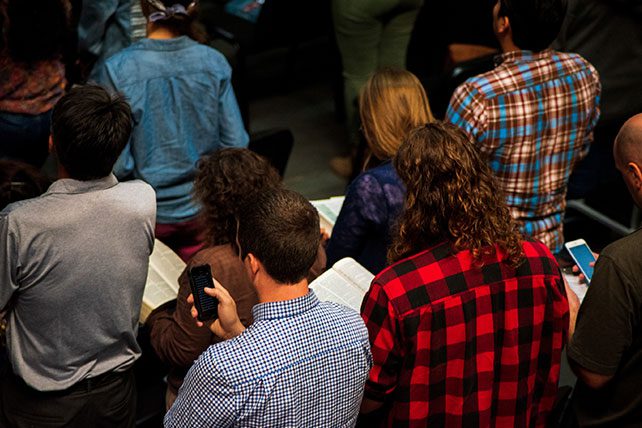A while back, a reader named Brad sent me this question: We seem to be developing a debate at our church in regards to turning down the house lights to “set the mood” for better worship. What is your take on that for church lighting? Later I received this about church lighting philosophy from another reader, Jeremy:
I was wondering if you could offer any commentary regarding the use of lights at any of the WorshipGod conferences. I have memories going back to the “Psalms” conference [in 2008]. In each of the conference settings, it has struck me that the lights in the house are left active during the music-worship time of gatherings. Is that intentional? Is that unintentional? Is it because no one is available to run a lights scheme?
Glad you asked. Yes, we do have someone available to run a lights scheme, and yes, leaving the lights up is intentional.
But we don’t.
More and more churches have chosen a church lighting philosophy to turn down the house lights when the congregation sings. Search for “worship” in Google images, and the majority are mostly dark or shadows.
RELATED: Church Stage Lighting
For a number of years I’ve wondered why. This is my attempt to share some of my thoughts. To be clear, I’m not going to address production lighting in general. On that topic, we should pursue what John Piper terms undistracting excellence—doing what we do so skillfully that people aren’t even aware of it. In this post I want to focus on the level of lighting for a congregation.
The Good Stuff About Church Lighting
I think I understand at least some of the reasons for turning the lights down.
- It keeps people from being distracted.
- It focuses people on the front.
- People feel more comfortable and less conspicuous.
- Screens and videos are easier to see when the room is dark.
- Lights can be used to direct people’s focus.
- Lights on the stage are less effective when the rest of the room is fully lit.
These are legitimate reasons for lowering the house lights. But I want to ask whether we should still consider turning the lights up. Or even on.
I recognize this issue falls far down the scale when it comes to crucial topics for the church to consider. But perhaps low lights can have unintended consequences.
The Not So Good Stuff About Church Lighting
Brad asked me what my take was on turning “the house lights down to set the mood for better worship.” His questions beg a few more questions.
Why does not seeing the congregation make for “better worship?”
What is the best “mood” for worship?
Should we be trying to set a mood through lighting?
When we start quantifying worship by the church lighting and mood, we’re already in trouble. We’ve slipped from viewing worship as a Spirit-enabled response to God’s self-revelation in the gospel to seeing it as an emotional experience that can be humanly produced and manipulated. Worship is not simply a mood. Aesthetic elements should support and complement our response to God’s Word and the gospel, not overpower it, distract from it or be the foundation for it.
God has given us means to motivate and affect people—the Word, prayer, the gospel. He’s given us the Lord’s Supper and baptism as visual and sensory ways to remember the gospel and its implications. Aesthetics like church lighting philosophy are important, but secondary. Every time in history the church has overly emphasized aesthetic and artistic elements, the gospel has suffered. So here are:
Church Lighting Philosophy – Turn the Lights Up
1. We’re speaking to one another.
When I go to a movie with Julie, I don’t mind that the theater is completely dark. I have zero interest in what the people around me are doing. I just want to see what’s on the screen. But a movie theater is not the church. The church is Christians meeting with God and each other around the gospel.
We’re commanded twice in the New Testament to speak to or teach and admonish one another as we sing (Eph. 5:19; Col. 3:16). That involves not only hearing others, but seeing them. When I’m not leading, I’ll look around a few times just to take in the fact that I’m singing God’s praise with other saints Christ has redeemed. I’m encouraged by their participation and the reality that I’m not alone!

